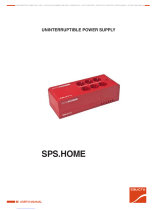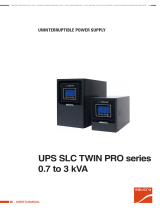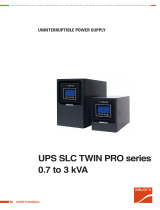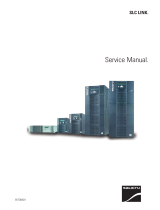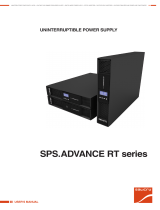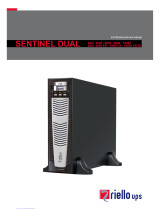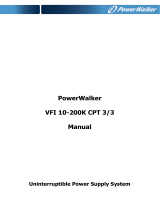
2
GENERAL INDEX
1. INTRODUCTION.
1.1 ACKNOWLEDGEMENT LETTER.
2. INFORMATION FOR SAFETY.
2.1. USING THIS MANUAL.
2.1.1. Conventions and used symbols.
3. STANDARD AND QUALITY GUARANTEE.
3.1. DECLARATION OF THE MANAGEMENT.
3.2. STANDARD.
3.2.1. First and second environment.
3.2.1.1. First environment.
3.2.1.2. Second environment.
3.3. ENVIRONMENT.
4. PRESENTATION.
4.1. VIE WS.
4.1.1. Views of the equipment.
4.1.2 Legend corresponding to the equipment views.
4.2. DEFINITION AND STRUCTURE.
4.2.1. Nomenclature.
4.2.2. Structural diagram.
4.3. UPS FUNCTION STAGES.
4.3.1. I/O EMI filters.
4.3.2. Rectifier-PFC stage (AC/DC).
4.3.3. Batteries.
4.3.4. Inverter stage (DC/AC).
4.3.5. Static bypass stage.
4.3.6. Maintenance or manual Bypass.
4.3.7. Terminals for EPO.
4.3.8. Control panel.
4.3.9. Control software and communications.
4.3.9.1. Control software at low level.
4.3.9.2. Managing software of the equipment.
4.3.9.3. Communications.
4.4. OPERATING PRINCIPLE OF AN EQUIPMENT.
4.4.1. Normal operating ().
4.4.2. Mains fault operating ().
4.4.3. Operating with non-active inverter ().
4.4.4. Manual bypass operating ().
4.4.5. Smart ECO Mode operating (/ ).
4.4.6. Frequency converter operating.
4.5. OPERATING STRUCTURE OF A PARALLEL SYSTEM.
5. INSTALLATION.
5.1. RECEPTION OF THE EQUIPMENT.
5.1.1. Reception, packaging and contents.
5.1.2. Storage.
5.1.3. Transport until its location.
5.1.4. Location, immobilised and considerations.
5.1.4.1. Location for single equipments.
5.1.4.2. Location for parallel systems.
5.1.4.3. Equipment immobilized and levelled.
5.1.4.4. Preliminary considerations before connecting.
5.1.4.5. Preliminary considerations before connecting, as regards to
batteries and protections.
5.1.4.6. Access to inside the cabinet for its connection.
5.2. CONNECTION.
5.2.1. Connection to mains, terminals (X1 to X4).
5.2.2. Connection of separate static bypass line, terminals (X14 a X17).
CUBE3+ B version only.
5.2.3. Connection to the output, terminals (X6 to X9).
5.2.4. Connection to the battery terminals of the equipment (X11, X12
and X23), with the battery modules (X47, X48 and X49).
5.2.5. Connection to the input main protecting earth terminal (X5) and
the earth bonding terminal (X10) .
5.2.6. Relay COM port. Connector (X32).
5.2.7. RS232/RS485 and USB COM 0 ports.
5.2.7.1. RS232/RS485 COM 0 ports. Connector (X31).
5.2.7.2. COM or USB port. Connector (X31USB).
5.2.8. EPO terminals (X50).
5.2.9. Auxiliary contact and battery temperature probe terminal strip.
5.2.9.1. Terminal strip, auxiliary contact of manual bypass switch (X51).
5.2.9.2. Terminal strip, auxiliary contact of output switch (X45).
5.2.9.3. Terminal strip, battery temperature probe (X34). For batteries in a
separate cabinet only.
5.2.9.4. Ethernet connectors (X34 ETH) in the UPS and (X38 ETH) in the battery
cabinet. For separate battery cabinets and probe bundle > 5 m,
only.
5.2.10. Connection of parallel BUS (X36i) and (X36o).
5.2.10.1.Connection of the communication or BUS bundle (BC).
6. OPERATING.
6.1. RELEVANT PRELIMINARY CONSIDERATIONS .
6.2. UPS OR SYSTEM START UP.
6.2.1. Controls before starting up.
6.2.2. Start up procedure.
6.2.2.1. First start up procedure.
6.2.2.2. Daily start up procedure, for equipments with alphanumerical
display.
6.2.2.3. Daily start up procedure, for equipments with touchscreen.
6.2.2.4. Considerations regarding Master and Slave (parallel systems only).
6.3. SHUTDOWN OF AN EQUIPMENT FROM PARALLEL SYSTEM.
6.4. TO START UP THE UPS OF PREVIOUS SECTION.
6.5. COMPLETE SHUTDOWN OF THE UPS OR SYSTEM.
6.6. EMERGENCY POWER OFF (EPO) BUTTON OPERATION.
6.7. SMART ECO MODE OPERATING.
6.8. MANUAL BYPASS SWITCH (MAINTENANCE).
6.8.1. Operating principle.
6.8.2. Transference to maintenance bypass.
6.8.3. Transference to normal operating, equipments with alphanumerical
panel.
6.8.4. Transference to normal operating, for equipments with touch
screen.
7. DESCRIPTION OF THE CONTROL PANEL.
7.1. CONTROL PANEL PARTS.
7.2. BASIC FUNCTIONS OF THE SYNOPTIC KEYPAD.
7.2.1. Messages menus and classification of the submenus.
7.3. SCREEN DESCRIPTION.
7.3.1. Main level (screen menu 0.0). See Fig 44.
7.3.2. ‘‘CONTROL AND STATUS OF THE EQUIPMENT" level See Fig 45.
7.3.3. ‘‘MEASUREMENT’’ level (screen menu 2.0). See fig. 46.
7.3.4. ‘‘PARAMETERS’’ level (screen menu 3.0). See fig 47.
USER MANUAL




















